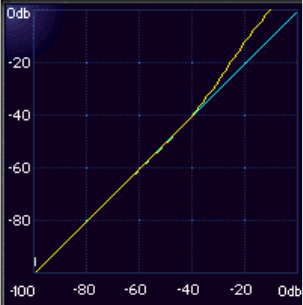
Waves LinMB software guide page 16 of 28
H
IGH
-
LEVEL EXPANSION
(
UPWARD EXPANDER
)
An upward expander from the C1, with a ratio of 0.75:1, Threshold at -35.
Equivalent LINMB setting would be a Range of +10 or so, quite a bit more
than you’d probably ever need. Shown only for clear example.
To make an upward expander (an “uncompressor”) to restore overly quashed
dynamics, simply reverse the Range setting. Make the Range be a positive
value, say between +2 and +5. Now whenever the signal is around or above
the Threshold, the output will be expanded upwards, with a maximum gain
increase of the value of Range. In other words, if Range is +3, then the
maximum expansion will be 3dB increase.
L
OW
-
LEVEL COMPRESSION
The low-level processors are where we start to have even more fun. By using
the fixed Gain control to offset the Range, you can affect only the lower-level
signals.
If you are interested in increasing the level of soft passages, but leaving the
louder passages untouched, (termed here ‘low-level compression’), set the
threshold to a low level (say –40 to –60dB). Set Range to a small negative
value, such as -5dB, and set Gain to the opposite value (+5dB). The audio
around and below the Threshold value will be “compressed upward” a
maximum of 5dB, and the higher audio levels will be untouched, including
their transients.
This will cause high levels signals (i.e. that are significantly above Threshold)
to have no gain Change – since at high levels the Range and Gain controls
are opposite values and together they equal unity gain. While around and
below the Threshold, the Range is increasingly “inactive” and therefore
approaches a zero-gain value. Gain is a fixed value, so the result is that the
low level signal is increased by the Gain control, achieving the so-called
“upward compression” concept.
This is very clear when you see this behavior on the LINMB display. Simply
look at the yellow DynamicLine while the input signal is low or high, and see
the resulting EQ curve. In a multiband compressor application, this low-level
compression is very handy to create a dynamic ‘Loudness Control’ that could
boost the LOW and HIGH bands only when their levels are low, as just one
example.


















